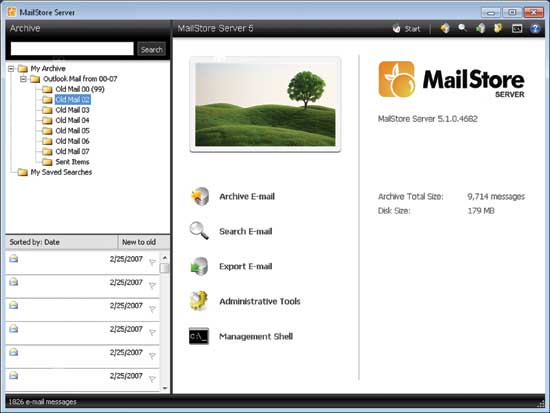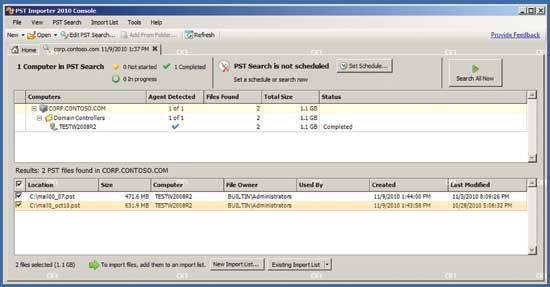Toolbox: New Products for IT Professionals
The tools in this month’s toolbox help you categorize, organize and archive e-mail from a variety of sources, and import PST files into Exchange 2010.
Greg Steen
MailStore Server
E-mail isn’t going away anytime soon. With the expanding set of regulatory requirements for e-mail archiving and the litigious society in which we live, we need easily accessible e-mail archives. Many organizations have a centralized e-mail server and repository, but many do not.
Not all companies have a disaster recovery or archival process in place to help mitigate both legal and hardware and software risks. If your company relies on third-party hosted mail, how can you be sure you’ll have access to the data you need when you need it?
MailStore Server, from deepinvent Software GmbH, can help ease the long-term security and availability of your e-mail. This is a multi-user, centralized mail archival application designed in a basic server/client configuration. It also serves as a repository for all end-user mail archives. The server component runs as a Windows service that you can control and configure through the MailStore Server Base Configuration interface.
You can start, stop or restart the service; see a log of MailStore-related events; and set the various configuration options for the application. Configuration options let you set the directory where the master database is stored and where the application settings are stored. You can also set the IP addresses and ports, whether you want to require HTTPS connections, and the SSL certificate the server should use to encrypt traffic (if you want to use one other than the default application-generated certificate).
The server supports direct Internet Message Access Protocol (IMAP) access you can enable and configure. There’s also a debug log for troubleshooting and double-checking server configurations. Most of the settings for the server are “set it and forget it” on install. You’ll spend most of your time in the MailStore Client. Within the client, you can archive or export e-mail, search mail archives and manage most of the day-to-day settings of MailStore Server.
For e-mail archiving, MailStore Server lets you import mail from a varied set of sources that include Microsoft Outlook, Microsoft Exchange, Windows Mail, Windows Live Mail, AVM KEN Mailbox, Mozilla Thunderbird, Mozilla SeaMonkey and Google Mail. You can also import directly from an IMAP or POP3 source, a PST or MBOX file, or a folder containing EML and/or MSG files.
One great feature of the MailStore Server import functionality is that for Microsoft Exchange and IMAP/POP3 sources, you can specify multiple mailboxes as a target. This feature is a must for larger environments. Specifically for Microsoft Exchange, you can import from a specific list of mailboxes, a set of public folders, or even automatically archive all inbound or outbound e-mail.
To help with Exchange integration, MailStore Server directly integrates with Active Directory and can automatically add new Exchange users to the MailStore Server database. You can schedule import tasks to run on an automated, recurring basis during off-hours without user intervention.
In terms of exporting mail from the MailStore Server archive, you can export to Outlook, Exchange, Thunderbird, SeaMonkey, Windows Mail or an IMAP mailbox. You can also export to the file system as EML or MSG files, send all the messages via SMTP to a specific address, or burn them directly to CD or DVD.
The search functionality within the client application lets you search the various parts of the e-mail including subject, body, priority, size and attachment names, as well as search within attachments themselves. You can also filter your search—specifying to or from whom the e-mail is addressed, or by a date range. You can save search criteria for later reuse.
The administrative tools section is the primary administrative interface for managing the application. Here you define your users—which you can import directly from Active Directory—and user privileges. You can also define storage locations, manage search indexes and create backups of your mail archives. You can see usage statistics and active sessions, as well.
MailStore Server is priced per user. The five-user license (the minimum) will run you $38 per user, or $190. There are discounts as you increase the number of licenses (200 will run you $13 per user). The one-time purchase license includes one year of free updates and technical support. There’s a 30-day free trial for download from the product Web site so you can try before you buy. If you don’t need multi-user support or direct PST importing, you may be able to use the MailStore Home Edition, which is free for personal use. If you’re looking for a simple, multi-client e-mail archiving and backup solution for your e-mail, have a look at MailStore Server.

MailStore Server
PST Importer 2010
If you’re moving from individual Outlook accounts to Exchange Server, you’ll most likely want to keep the e-mails and contacts stored locally in your user profiles. Microsoft Outlook stores all the mail and contact data in files with the extension PST. Getting these PST files imported into Exchange can be a troublesome and tedious task (although there are built-in Exchange administration tools that can somewhat help you do this).
PST Importer 2010 from Red Gate Software Ltd. lets you import your PST files into Exchange 2007 or 2010 en masse from a central location, which can save you hours of time and a lot of hassle. PST Importer 2010 distills the process into two primary steps—PST Search searches for PSTs and Import Lists imports sets of those PST files to Exchange.
To define a PST Search, select the domain or domain subset you wish to search, select which locations on the target machines to search, select when you want to search and name the PST Search so you can reuse it at a later date. You can choose to search “everywhere” or in specific folders for “permanent” hard drives, or even target removable drives. You can also choose to ignore directories such as system folders or program files. You can run PST Searches manually or by schedule to help you minimize network and machine resource utilization.
Once you’ve run a PST Search, you can define an Import List to bring the data into Exchange. If you’ve collected your PST files into a single directory, you can actually just point to the folder and it will create an import list from there. You can import messages directly to Exchange mailboxes by mapping each PST to the respective user’s box. You can also import them into a folder structure based on the filename or single folder. This is helpful for archiving or disaster recovery. PST Importer 2010 will also automatically import Calendar items, contacts, tasks and notes.
To ensure that corrupted PSTs don’t slow you down, you can define a failed message tolerance to keep from importing bad data. PST Importer 2010 lets you save multiple PST Searches and Import Lists, so you can target varied implementations.
If you’re upgrading to Exchange and need a way to automatically import old PST data, consider Red Gate PST Importer 2010. PST Importer 2010 is licensed per server. It starts at $495 per server, with additional discounts as volume increases. There’s a 14-day trial available for download from the product site.

PST Importer 2010
.jpg)
Greg Steen* is a technology professional, entrepreneur and enthusiast. He’s always on the hunt for new tools to help make operations, QA and development easier for the IT professional.*